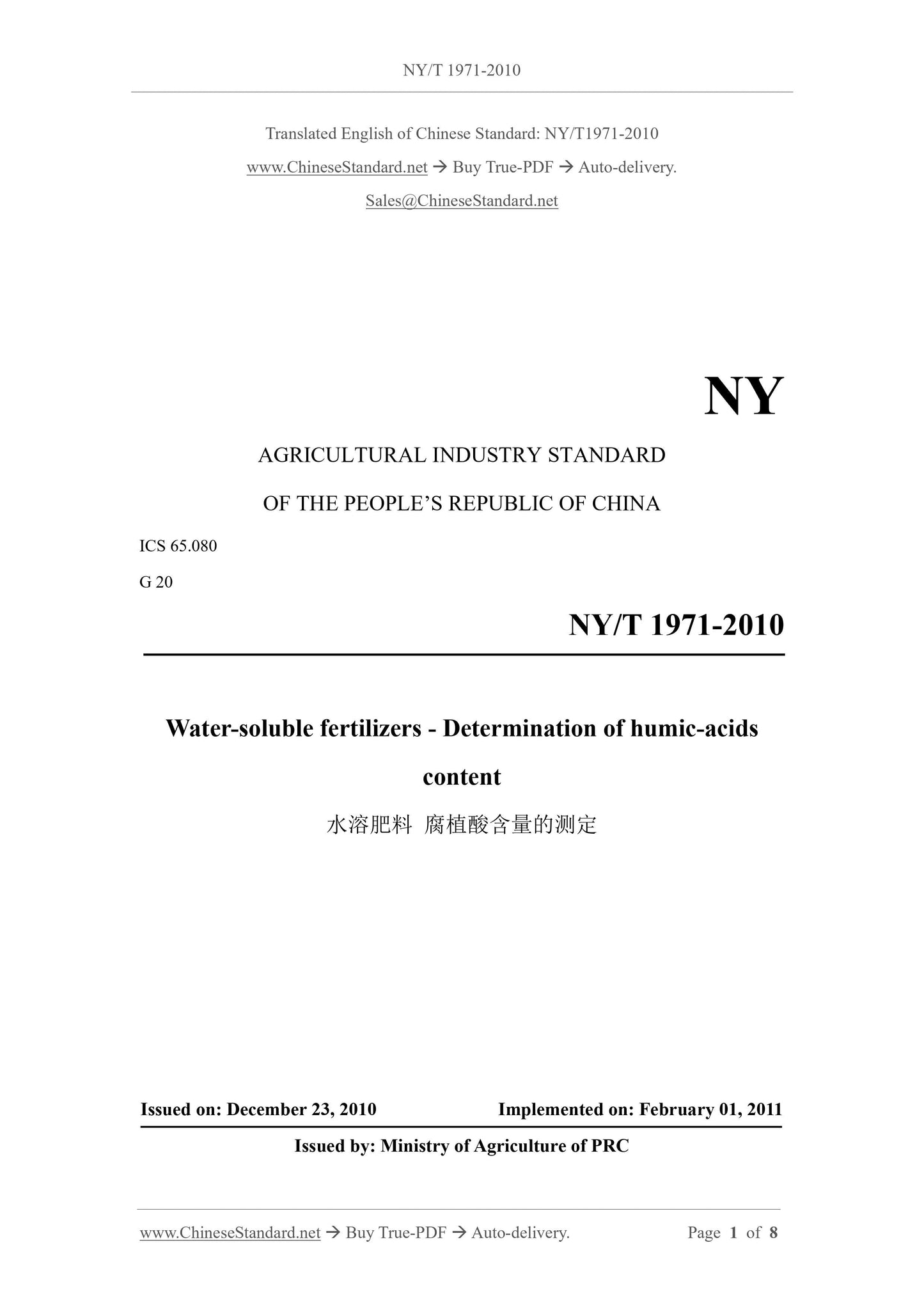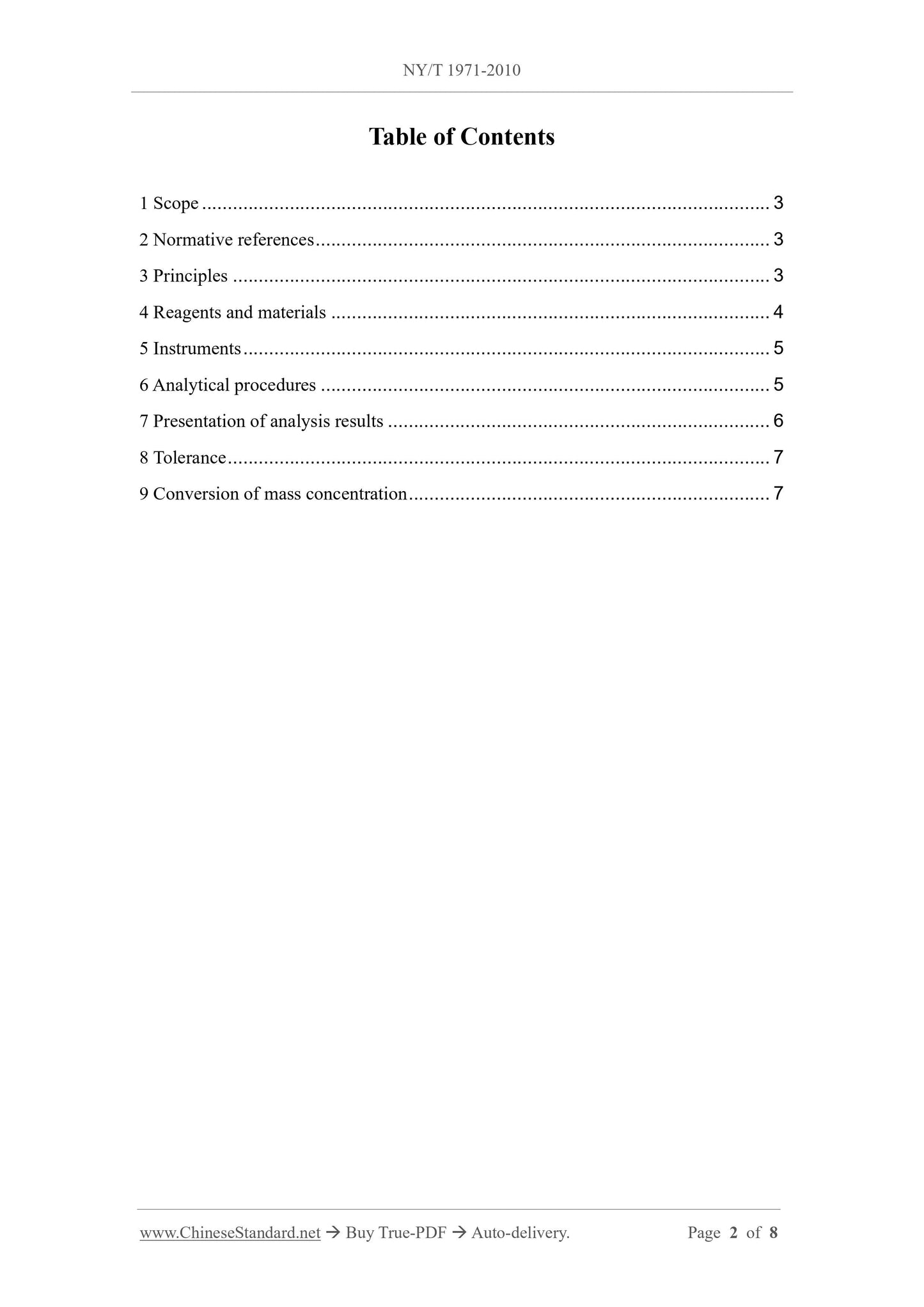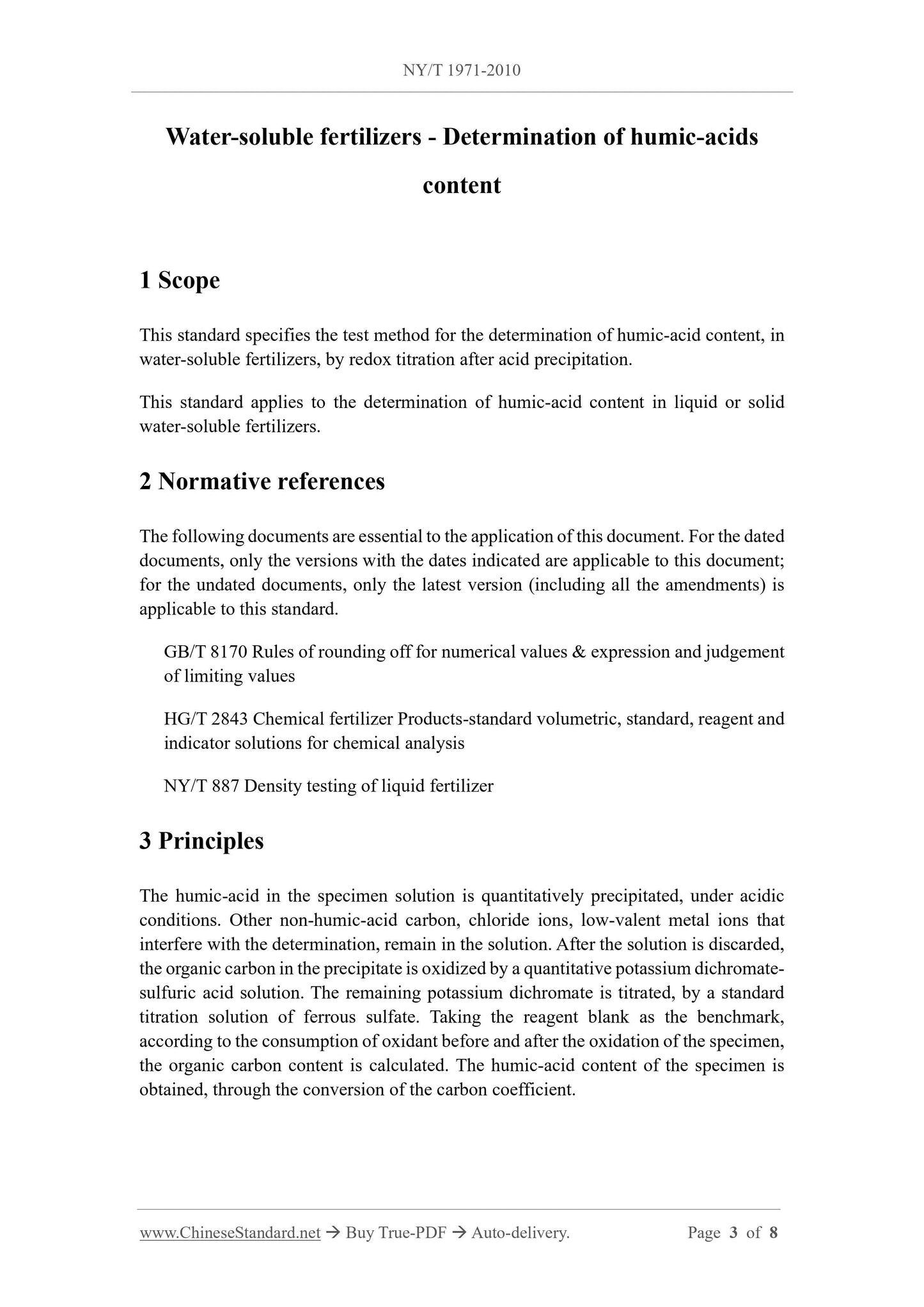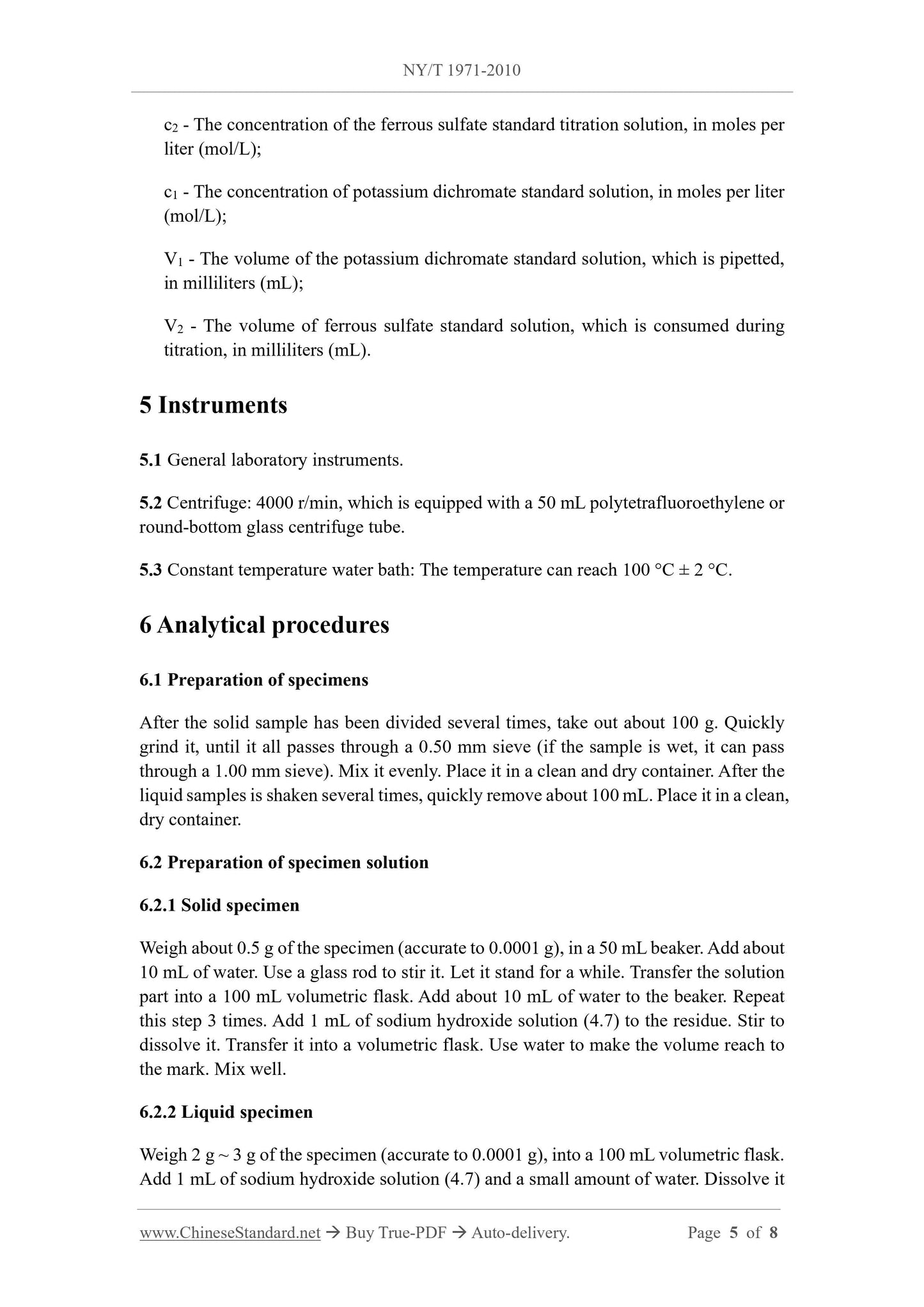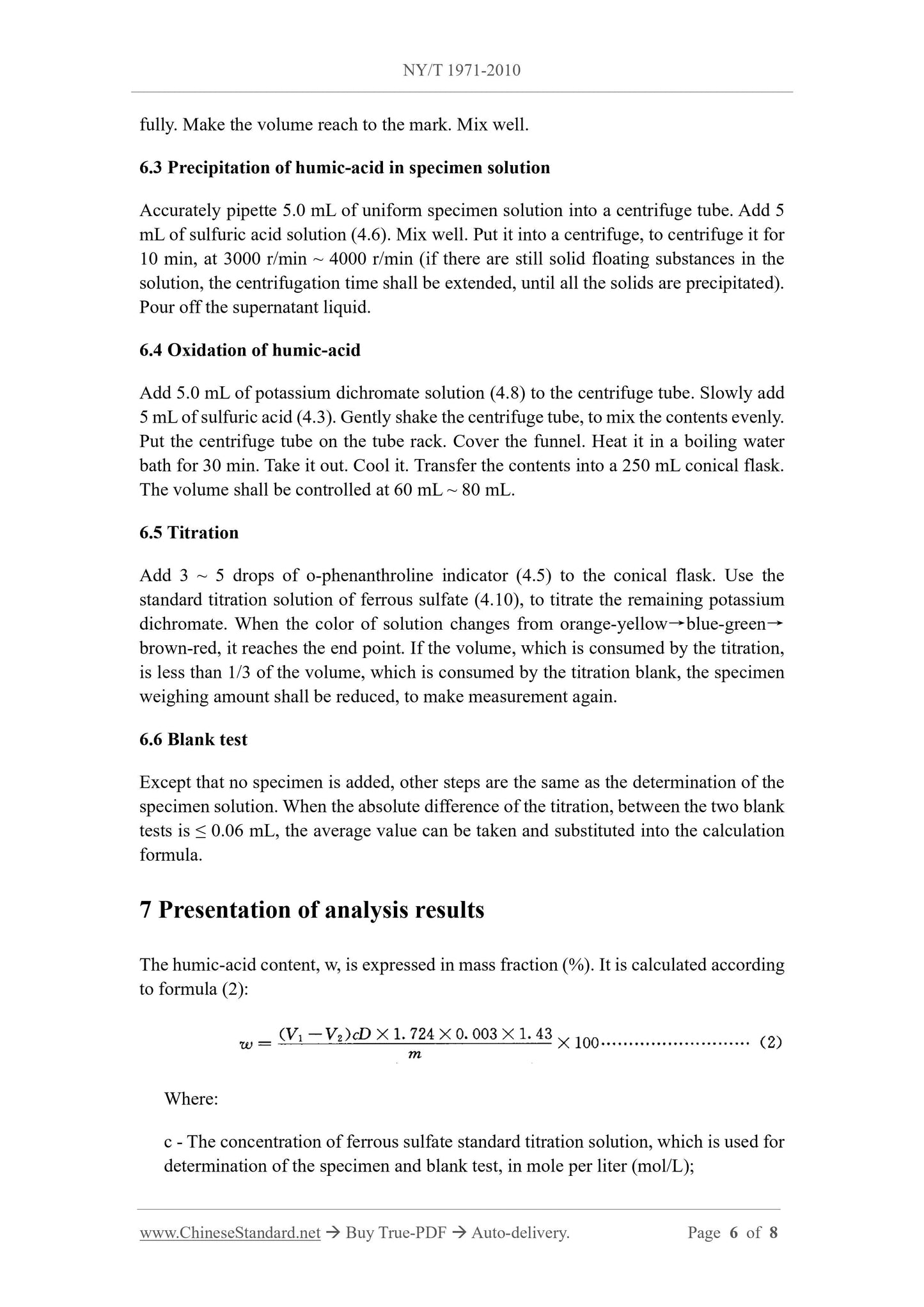1
/
of
5
PayPal, credit cards. Download editable-PDF and invoice in 1 second!
NY/T 1971-2010 English PDF (NY/T1971-2010)
NY/T 1971-2010 English PDF (NY/T1971-2010)
Regular price
$135.00 USD
Regular price
Sale price
$135.00 USD
Unit price
/
per
Shipping calculated at checkout.
Couldn't load pickup availability
Delivery: 3 seconds. Download true-PDF + Invoice.
Get QUOTATION in 1-minute: Click NY/T 1971-2010
Historical versions: NY/T 1971-2010
Preview True-PDF (Reload/Scroll if blank)
NY/T 1971-2010: Water-soluble fertilizers - Determination of humic-acids content
NY/T 1971-2010
AGRICULTURAL INDUSTRY STANDARD
OF THE PEOPLE’S REPUBLIC OF CHINA
ICS 65.080
G 20
Water-soluble fertilizers - Determination of humic-acids
content
ISSUED ON: DECEMBER 23, 2010
IMPLEMENTED ON: FEBRUARY 01, 2011
Issued by: Ministry of Agriculture of PRC
Table of Contents
1 Scope ... 3
2 Normative references ... 3
3 Principles ... 3
4 Reagents and materials ... 4
5 Instruments ... 5
6 Analytical procedures ... 5
7 Presentation of analysis results ... 6
8 Tolerance ... 7
9 Conversion of mass concentration ... 7
Water-soluble fertilizers - Determination of humic-acids
content
1 Scope
This standard specifies the test method for the determination of humic-acid content, in
water-soluble fertilizers, by redox titration after acid precipitation.
This standard applies to the determination of humic-acid content in liquid or solid
water-soluble fertilizers.
2 Normative references
The following documents are essential to the application of this document. For the dated
documents, only the versions with the dates indicated are applicable to this document;
for the undated documents, only the latest version (including all the amendments) is
applicable to this standard.
GB/T 8170 Rules of rounding off for numerical values and expression and judgement
of limiting values
HG/T 2843 Chemical fertilizer Products-standard volumetric, standard, reagent and
indicator solutions for chemical analysis
NY/T 887 Density testing of liquid fertilizer
3 Principles
The humic-acid in the specimen solution is quantitatively precipitated, under acidic
conditions. Other non-humic-acid carbon, chloride ions, low-valent metal ions that
interfere with the determination, remain in the solution. After the solution is discarded,
the organic carbon in the precipitate is oxidized by a quantitative potassium dichromate-
sulfuric acid solution. The remaining potassium dichromate is titrated, by a standard
titration solution of ferrous sulfate. Taking the reagent blank as the benchmark,
according to the consumption of oxidant before and after the oxidation of the specimen,
the organic carbon content is calculated. The humic-acid content of the specimen is
obtained, through the conversion of the carbon coefficient.
c2 - The concentration of the ferrous sulfate standard titration solution, in moles per
liter (mol/L);
c1 - The concentration of potassium dichromate standard solution, in moles per liter
(mol/L);
V1 - The volume of the potassium dichromate standard solution, which is pipetted,
in milliliters (mL);
V2 - The volume of ferrous sulfate standard solution, which is consumed during
titration, in milliliters (mL).
5 Instruments
5.1 General laboratory instruments.
5.2 Centrifuge: 4000 r/min, which is equipped with a 50 mL polytetrafluoroethylene or
round-bottom glass centrifuge tube.
5.3 Constant temperature water bath: The temperature can reach 100 °C ± 2 °C.
6 Analytical procedures
6.1 Preparation of specimens
After the solid sample has been divided several times, take out about 100 g. Quickly
grind it, until it all passes through a 0.50 mm sieve (if the sample is wet, it can pass
through a 1.00 mm sieve). Mix it evenly. Place it in a clean and dry container. After the
liquid samples is shaken several times, quickly remove about 100 mL. Place it in a clean,
dry container.
6.2 Preparation of specimen solution
6.2.1 Solid specimen
Weigh about 0.5 g of the specimen (accurate to 0.0001 g), in a 50 mL beaker. Add about
10 mL of water. Use a glass rod to stir it. Let it stand for a while. Transfer the solution
part into a 100 mL volumetric flask. Add about 10 mL of water to the beaker. Repeat
this step 3 times. Add 1 mL of sodium hydroxide solution (4.7) to the residue. Stir to
dissolve it. Transfer it into a volumetric flask. Use water to make the volume reach to
the mark. Mix well.
6.2.2 Liquid specimen
Weigh 2 g ~ 3 g of the specimen (accurate to 0.0001 g), into a 100 mL volumetric flask.
Add 1 mL of sodium hydroxide solution (4.7) and a small amount of water. Dissolve it
fully. Make the volume reach to the mark. Mix well.
6.3 Precipitation of humic-acid in specimen solution
Accurately pipette 5.0 mL of uniform specimen solution into a centrifuge tube. Add 5
mL of sulfuric acid solution (4.6). Mix well. Put it into a centrifuge, to centrifuge it for
10 min, at 3000 r/min ~ 4000 r/min (if there are still solid floating substances in the
solution, the centrifugation time shall be extended, until all the solids are precipitated).
Pour off the supernatant liquid.
6.4 Oxidation of humic-acid
Add 5.0 mL of potassium dichromate solution (4.8) to the centrifuge tube. Slowly add
5 mL of sulfuric acid (4.3). Gently shake the centrifuge tube, to mix the contents evenly.
Put the centrifuge tube on the tube rack. Cover the funnel. Heat it in a boiling water
bath for 30 min. Take it out. Cool it. Transfer the contents into a 250 mL conical flask.
The volume shall be controlled at 60 mL ~ 80 mL.
6.5 Titration
Add 3 ~ 5 drops of o-phenanthroline indicator (4.5) to the conical flask. Use the
standard titration solution of ferrous sulfate (4.10), to titrate the remaining potassium
dichromate. When the color of solution changes from orange-yellow→blue-green→
brown-red, it reaches the end point. If the volume, which is consumed by the titration,
is less than 1/3 of the volume, which is consumed by the titration blank, the specimen
weighing amount shall be reduced, to make measurement again.
6.6 Blank test
Except that no specimen is added, other steps are the same as the determination of the
specimen solution. When the absolute difference of the titration, between the two blank
tests is ≤ 0.06 mL, the average value can be taken and substituted into the calculation
formula.
7 Presentation of analysis results
The humic-acid content, w, is expressed in mass fraction (%). It is calculated according
to formula (2):
Where:
c - The concentration of ferrous sulfate standard titration solution, which is used for
determination of the specimen and blank test, in mole per liter (mol/L);
Get QUOTATION in 1-minute: Click NY/T 1971-2010
Historical versions: NY/T 1971-2010
Preview True-PDF (Reload/Scroll if blank)
NY/T 1971-2010: Water-soluble fertilizers - Determination of humic-acids content
NY/T 1971-2010
AGRICULTURAL INDUSTRY STANDARD
OF THE PEOPLE’S REPUBLIC OF CHINA
ICS 65.080
G 20
Water-soluble fertilizers - Determination of humic-acids
content
ISSUED ON: DECEMBER 23, 2010
IMPLEMENTED ON: FEBRUARY 01, 2011
Issued by: Ministry of Agriculture of PRC
Table of Contents
1 Scope ... 3
2 Normative references ... 3
3 Principles ... 3
4 Reagents and materials ... 4
5 Instruments ... 5
6 Analytical procedures ... 5
7 Presentation of analysis results ... 6
8 Tolerance ... 7
9 Conversion of mass concentration ... 7
Water-soluble fertilizers - Determination of humic-acids
content
1 Scope
This standard specifies the test method for the determination of humic-acid content, in
water-soluble fertilizers, by redox titration after acid precipitation.
This standard applies to the determination of humic-acid content in liquid or solid
water-soluble fertilizers.
2 Normative references
The following documents are essential to the application of this document. For the dated
documents, only the versions with the dates indicated are applicable to this document;
for the undated documents, only the latest version (including all the amendments) is
applicable to this standard.
GB/T 8170 Rules of rounding off for numerical values and expression and judgement
of limiting values
HG/T 2843 Chemical fertilizer Products-standard volumetric, standard, reagent and
indicator solutions for chemical analysis
NY/T 887 Density testing of liquid fertilizer
3 Principles
The humic-acid in the specimen solution is quantitatively precipitated, under acidic
conditions. Other non-humic-acid carbon, chloride ions, low-valent metal ions that
interfere with the determination, remain in the solution. After the solution is discarded,
the organic carbon in the precipitate is oxidized by a quantitative potassium dichromate-
sulfuric acid solution. The remaining potassium dichromate is titrated, by a standard
titration solution of ferrous sulfate. Taking the reagent blank as the benchmark,
according to the consumption of oxidant before and after the oxidation of the specimen,
the organic carbon content is calculated. The humic-acid content of the specimen is
obtained, through the conversion of the carbon coefficient.
c2 - The concentration of the ferrous sulfate standard titration solution, in moles per
liter (mol/L);
c1 - The concentration of potassium dichromate standard solution, in moles per liter
(mol/L);
V1 - The volume of the potassium dichromate standard solution, which is pipetted,
in milliliters (mL);
V2 - The volume of ferrous sulfate standard solution, which is consumed during
titration, in milliliters (mL).
5 Instruments
5.1 General laboratory instruments.
5.2 Centrifuge: 4000 r/min, which is equipped with a 50 mL polytetrafluoroethylene or
round-bottom glass centrifuge tube.
5.3 Constant temperature water bath: The temperature can reach 100 °C ± 2 °C.
6 Analytical procedures
6.1 Preparation of specimens
After the solid sample has been divided several times, take out about 100 g. Quickly
grind it, until it all passes through a 0.50 mm sieve (if the sample is wet, it can pass
through a 1.00 mm sieve). Mix it evenly. Place it in a clean and dry container. After the
liquid samples is shaken several times, quickly remove about 100 mL. Place it in a clean,
dry container.
6.2 Preparation of specimen solution
6.2.1 Solid specimen
Weigh about 0.5 g of the specimen (accurate to 0.0001 g), in a 50 mL beaker. Add about
10 mL of water. Use a glass rod to stir it. Let it stand for a while. Transfer the solution
part into a 100 mL volumetric flask. Add about 10 mL of water to the beaker. Repeat
this step 3 times. Add 1 mL of sodium hydroxide solution (4.7) to the residue. Stir to
dissolve it. Transfer it into a volumetric flask. Use water to make the volume reach to
the mark. Mix well.
6.2.2 Liquid specimen
Weigh 2 g ~ 3 g of the specimen (accurate to 0.0001 g), into a 100 mL volumetric flask.
Add 1 mL of sodium hydroxide solution (4.7) and a small amount of water. Dissolve it
fully. Make the volume reach to the mark. Mix well.
6.3 Precipitation of humic-acid in specimen solution
Accurately pipette 5.0 mL of uniform specimen solution into a centrifuge tube. Add 5
mL of sulfuric acid solution (4.6). Mix well. Put it into a centrifuge, to centrifuge it for
10 min, at 3000 r/min ~ 4000 r/min (if there are still solid floating substances in the
solution, the centrifugation time shall be extended, until all the solids are precipitated).
Pour off the supernatant liquid.
6.4 Oxidation of humic-acid
Add 5.0 mL of potassium dichromate solution (4.8) to the centrifuge tube. Slowly add
5 mL of sulfuric acid (4.3). Gently shake the centrifuge tube, to mix the contents evenly.
Put the centrifuge tube on the tube rack. Cover the funnel. Heat it in a boiling water
bath for 30 min. Take it out. Cool it. Transfer the contents into a 250 mL conical flask.
The volume shall be controlled at 60 mL ~ 80 mL.
6.5 Titration
Add 3 ~ 5 drops of o-phenanthroline indicator (4.5) to the conical flask. Use the
standard titration solution of ferrous sulfate (4.10), to titrate the remaining potassium
dichromate. When the color of solution changes from orange-yellow→blue-green→
brown-red, it reaches the end point. If the volume, which is consumed by the titration,
is less than 1/3 of the volume, which is consumed by the titration blank, the specimen
weighing amount shall be reduced, to make measurement again.
6.6 Blank test
Except that no specimen is added, other steps are the same as the determination of the
specimen solution. When the absolute difference of the titration, between the two blank
tests is ≤ 0.06 mL, the average value can be taken and substituted into the calculation
formula.
7 Presentation of analysis results
The humic-acid content, w, is expressed in mass fraction (%). It is calculated according
to formula (2):
Where:
c - The concentration of ferrous sulfate standard titration solution, which is used for
determination of the specimen and blank test, in mole per liter (mol/L);
Share
